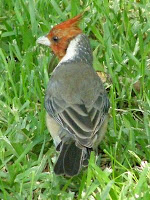This morning it's raining in Buenos Aires. We feel more at home every day. The last three days we've spent exploring our neighborhood here in Recoleta, twice to the
Museo Nacional de Bellas Artes. Their online site is excellent, allowing users to search by theme or artist.
Here we discovered Argentinian artists. Their regional and modern paintings dazzled us with vivid colors and fresh visions of South America. We both selected
Nicolas Garcia Uriburu, painting, a lovely garish red rendition of the "Three Graces" with floating cats, as best of show.

One small room at the museum had been set aside for a few very select artifacts from Pre-Columbian culture -- absolutely beautiful, including textiles, just tiny traceries of threads in complex patterns over a thousand years old, their color and texture protected by dry desert. Yet one stood out very different from the rest, a Chancay textile sculpture of a tree of life said to be from central Peru, acquired in 1989, but no date given. I'm assuming this three-dimensional sculpture is modern.
My efforts to find more information online so far have been unsuccessful for this very unique sculpture, though in Santiago last May, about 350 dancers celebrated
La Fiesta de la Chakana. The
Chakana is widely known as the Incan cross, and also referred to as a symbol for the tree of life. The chakana is a multi-dimensional icon of ancient Peruvian cultures, ssymbolizing their world view, the shaman's journey to other dimensions, and our relationship to the cosmos. The symbol shows up everywhere, on ancient religious artifacts, on contemporary jewelry, and can be seen in the very architecture of temple ruins. When I first saw this symbol, I immediately thought of the stepped pyramid
tablo/tablera of Aztec fame. The best site I've found for explaining this (and with lovely images) is thru the HUB's article on the
Incan Cross.
Another delight has been identifying some of the birds and trees we've encountered. Somehow Buenos Aires seemed stranger when I could see these lovely birds around me and not be able to name them, as if naming them created a certain familiarity -- Rufous-bellied thrush, chalk-browed Mockingbird, and a Rufous Ovenbird. This
Atlas Ambiental de Buenos Aires is a wonderful local resource with pictures of birds, trees (their flowers, fruits, leaves), and much more.
The Floss Silk Tree (see below) has such magnificant flowers, now in bloom. Sycamores (also known as the London Plane tree) have been planted everywhere along the streets, giving a small town feel to our neighborhood. We stroll past shops offering the freshest fruits, cheeses, olives, fish, wines, and, our favorite, breads of every imagination. Yesterday our lunch featured tiny squash stuffed with tender beef and covered with bechamel, with a side pure of sweet potato. Ah, art, culture, delicious food, and even rain.







